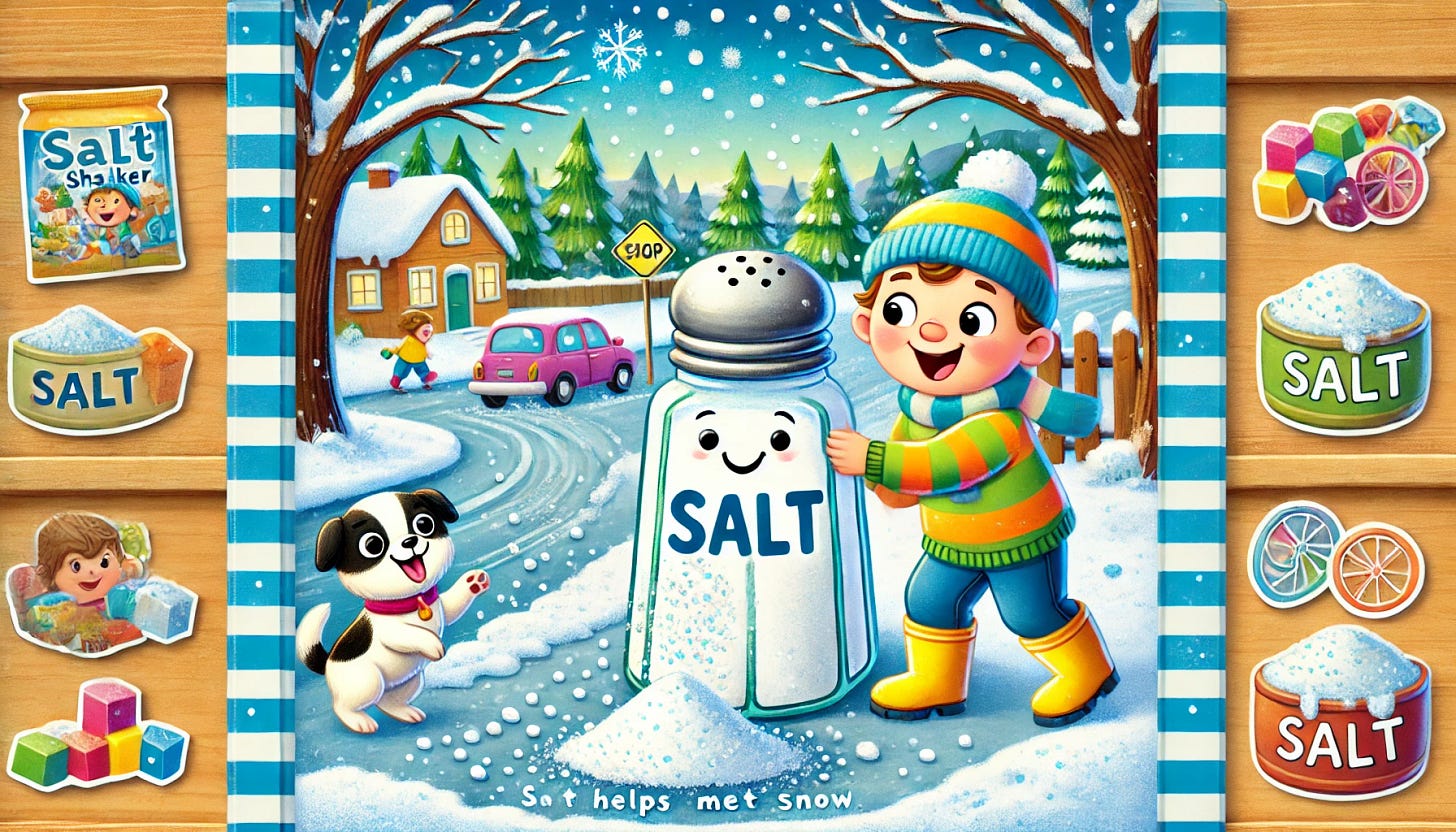Why Does Salt Melt Snow?
Imagine waking up to find your yard and street covered in a blanket of fluffy white snow. It’s beautiful, but snow and ice can make it hard to walk or drive. That’s where salt comes in!
Hello my friends!
For a quick note, welcome to Tidbits with Titus, a podcast and newsletter where we tackle the big, curious questions kids ask every day in fun, bite-sized ways! I’m Alexander Titus, but I go by Titus. I’m a scientist, adventurer, and a huge fan of making science, technology, and life accessible to all ages. From “How does electricity work?” to “What are taxes?” and even “Why is the sky blue?” I’m here to dive into these wonder-filled questions with engaging stories and simple explanations that spark curiosity and make learning a joy. This effort is all about creating a space where families can learn together, discover the magic of the every day, and find thoughtful ways to explore the world’s big mysteries. Let’s make curiosity a family tradition—one tidbit at a time!
Just so you know, these podcast episodes are all AI-generated using Google’s really cool NotebookLM technology. That means there are some errors in how words are said, but that is part of the fun!
If your little ones have questions that you want help answering, shoot me an email at questions@tidbitswithtitus.com and I’ll see what I can do!
You can subscribe to the newsletter that has this information as well at tidbitswithtitus.com.
Also please share with anyone you think would be interested. The more the merrier!
Cheers,
-Titus
What Is Snow Made Of?
Snow is made of tiny ice crystals that form in the clouds when water freezes. These crystals stick together and fall to the ground as snowflakes. Each snowflake is unique, with its own special shape, but they all have one thing in common—they’re made of frozen water, also known as ice!
Why Does Ice Feel So Cold?
Ice is cold because it’s frozen. For water to turn into ice, its temperature has to drop below 32 degrees Fahrenheit (0 degrees Celsius). At this temperature, water molecules slow down and stick together tightly, forming a solid. That’s why ice feels hard and cold.
What Happens When Salt Meets Ice?
Here’s where the magic happens! When you sprinkle salt on snow or ice, it changes how water molecules behave. Salt lowers the freezing point of water. That means the ice doesn’t stay frozen at 32°F anymore—it needs to be even colder to stay solid. If the temperature is above the new freezing point, the ice starts to melt.
How Does Salt Lower the Freezing Point?
Salt is made of tiny particles called sodium and chloride, which are ions. When you put salt on ice, it mixes with the thin layer of water on the surface of the ice. The salt particles get in the way of the water molecules trying to freeze again. This makes it harder for the ice to stay frozen, so it melts!
Why Doesn’t Salt Work in Really Cold Weather?
Salt works best when it’s a little cold but not freezing cold. If the temperature drops too low—below about 15°F (-9°C)—there isn’t enough water on the surface of the ice for the salt to mix with. Without this water, salt can’t do its job, and the ice stays frozen.
Different Types of Salt for Melting Snow
Did you know there are different types of salt? The salt you see on icy roads is not the same as the salt on your French fries! Here are some common types of salt used to melt snow:
Rock Salt: This is the most common type. It’s made from the same mineral as table salt, but the grains are larger and not as pure.
Calcium Chloride: This salt works in colder temperatures than regular rock salt. It’s like a superhero for super-cold days!
Magnesium Chloride: This salt is less harmful to plants and pets, making it a gentler choice for icy sidewalks.
Why Do We Use Salt on Roads?
Snow and ice on roads can be very slippery and dangerous. Cars can slide, and people can fall. By sprinkling salt on the roads, we make the ice melt, creating a safer surface for everyone. Salt also helps prevent new ice from forming when temperatures drop again.
Is Salt Safe for the Environment?
While salt helps keep us safe in winter, it can also cause problems for the environment. Too much salt can harm plants, animals, and even the water we drink. That’s why people are working on finding new ways to melt ice, like using sand, beet juice, or even cheese brine!
Can You Melt Snow Without Salt?
Yes! Here are a few other ways to melt snow:
Sand: Sand doesn’t melt snow, but it gives better traction on slippery surfaces.
Hot Water: Pouring warm water on ice can melt it, but it might refreeze later.
Special Deicers: These are made of chemicals that work like salt but are less harmful to the environment.
Fun Experiments to Try at Home
Want to see how salt melts ice? Try these fun experiments:
Salt and Ice Cubes: Put an ice cube on a plate. Sprinkle salt on it and watch what happens. The ice will start to melt where the salt touches it!
Salt and String Trick: Lay a piece of string on an ice cube. Sprinkle salt on top, wait a few seconds, and then pull the string. The ice will stick to the string!
Salt vs. Sugar: Try sprinkling salt on one ice cube and sugar on another. Which one melts faster?
Why Is This Important?
Understanding how salt melts snow helps us stay safe in winter and teaches us about the amazing world of science. When we know how things work, we can make better choices, like using salt carefully to protect the environment.
Conclusion
So, why does salt melt snow? It’s all about lowering the freezing point of water, making it harder for ice to stay frozen. Salt might seem simple, but it plays a big role in keeping roads safe and winter adventures fun. The next time you see someone spreading salt on a snowy sidewalk, you’ll know the science behind it!














Share this post